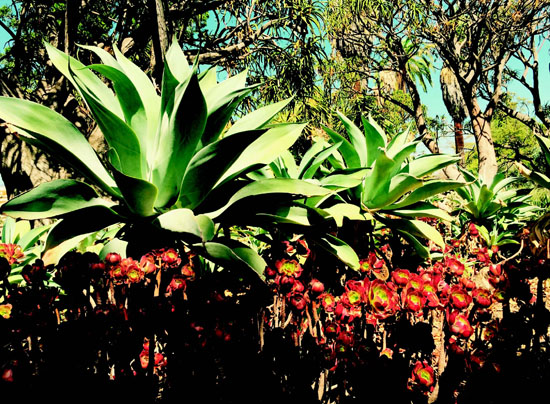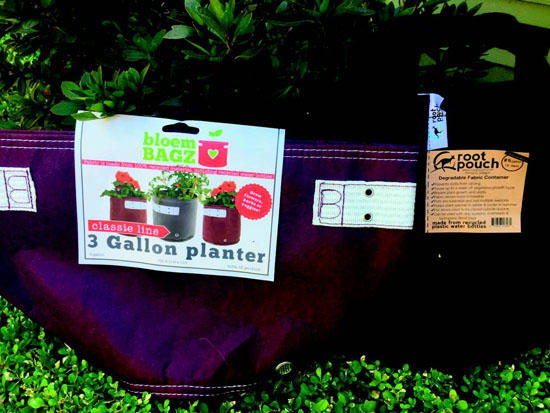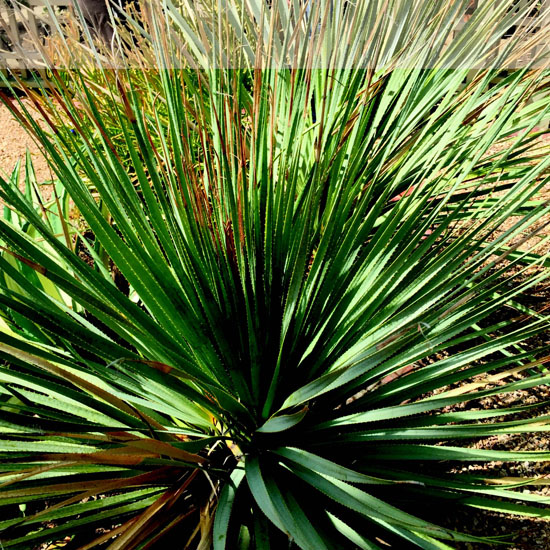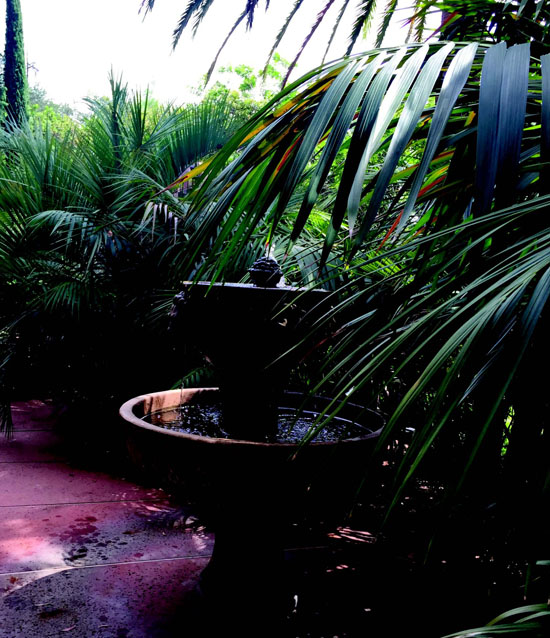 | | | Agave and succulents thrive in dry conditions. Photos Cynthia Brian | | | | | | "If something you are doing is not working, doing more of it won't work any better." - Unknown
 Spring, summer and fall have always been my most favorite seasons because I thrive in the sunshine, relish the warmth and indulge my senses in the lavish, lush beauty of the landscapes of California. This year has been an exception to my predilection as my garden is straining to survive in this thirsty environment. As I was writing this column, the skies sprinkled droplets of rain and I was so excited I stood outside with my face to the darkened heavens blissfully grateful for this tiny bit of moisture. Water, our most valuable resource, is becoming increasingly precious as our climate changes. The way we have been functioning in our gardens isn't working any longer.
Spring, summer and fall have always been my most favorite seasons because I thrive in the sunshine, relish the warmth and indulge my senses in the lavish, lush beauty of the landscapes of California. This year has been an exception to my predilection as my garden is straining to survive in this thirsty environment. As I was writing this column, the skies sprinkled droplets of rain and I was so excited I stood outside with my face to the darkened heavens blissfully grateful for this tiny bit of moisture. Water, our most valuable resource, is becoming increasingly precious as our climate changes. The way we have been functioning in our gardens isn't working any longer.
 I was privileged to be a speaker at the recent National Gardening Symposium held in the horticultural wonderland of Pasadena where the temperatures exceeded 100 degrees on a daily basis. It was hot, hotter, and hottest as the thermometer hit 107. Although considered a Mediterranean climate, it felt more Saharan. Attendees hailed from all around the United States, Great Britain, Canada, New Zealand and Australia, as well as a few other countries with the most discussed topic being H20. Trees were at the top of the list of plantings that must be saved. The world is watching California as we struggle to find a path to water conservation.
I was privileged to be a speaker at the recent National Gardening Symposium held in the horticultural wonderland of Pasadena where the temperatures exceeded 100 degrees on a daily basis. It was hot, hotter, and hottest as the thermometer hit 107. Although considered a Mediterranean climate, it felt more Saharan. Attendees hailed from all around the United States, Great Britain, Canada, New Zealand and Australia, as well as a few other countries with the most discussed topic being H20. Trees were at the top of the list of plantings that must be saved. The world is watching California as we struggle to find a path to water conservation.
 On a behind-the-scenes tour of the Los Angeles County Arboretum, I learned about an age-old technique used in Eastern Europe called "hugelkultur." Translated from German, it means "mound culture," because the practice involves salvaging limbs, branches, and debris to make raised beds that will improve draining and grow gardens without irrigation or fertilization. The Arboretum team removed a large lawn from an area where they are now experimenting with various ways to save and harvest water by slowing it down, spreading it out, and filtering it. Hugelkultur is something that many of us could embrace, especially with our compacted clay soil. For large properties with slopes or trees that have fallen or need to be cut down, hugelkultur could be a godsend. The process to design a hugel is simple.
On a behind-the-scenes tour of the Los Angeles County Arboretum, I learned about an age-old technique used in Eastern Europe called "hugelkultur." Translated from German, it means "mound culture," because the practice involves salvaging limbs, branches, and debris to make raised beds that will improve draining and grow gardens without irrigation or fertilization. The Arboretum team removed a large lawn from an area where they are now experimenting with various ways to save and harvest water by slowing it down, spreading it out, and filtering it. Hugelkultur is something that many of us could embrace, especially with our compacted clay soil. For large properties with slopes or trees that have fallen or need to be cut down, hugelkultur could be a godsend. The process to design a hugel is simple.

 1. Choose an area where you want a mound.
1. Choose an area where you want a mound.
 2. Gather logs, branches, twigs, other wood debris and leaves to line the area. Don't use wood from Black locust, walnut or cedar because of toxicity. Rotted wood is great.
2. Gather logs, branches, twigs, other wood debris and leaves to line the area. Don't use wood from Black locust, walnut or cedar because of toxicity. Rotted wood is great.
 3. First lay the big logs, add a layer of branches, then twigs, then leaves and grass clippings. Make the mound a minimum of three feet; seven feet or more is best. The mound will compact and shrink.
3. First lay the big logs, add a layer of branches, then twigs, then leaves and grass clippings. Make the mound a minimum of three feet; seven feet or more is best. The mound will compact and shrink.
 4. Water the layers.
4. Water the layers.
 5. Add kitchen scraps, compost, and mulch. Wood is high in carbon and could leach nitrogen from the soil. Compost is a necessary ingredient.
5. Add kitchen scraps, compost, and mulch. Wood is high in carbon and could leach nitrogen from the soil. Compost is a necessary ingredient.
 6. Add two inches of topsoil and more mulch.
6. Add two inches of topsoil and more mulch.
 7. Prepare your beds now in the fall so they will cure for a spring planting.
7. Prepare your beds now in the fall so they will cure for a spring planting.
 My hugelkultur trial will start soon as it is definitely more environmentally friendly to utilize the wood debris that I encounter in my gardening maintenance than putting it in the green bins. Plus, I love the look of rounded hills in landscapes.
My hugelkultur trial will start soon as it is definitely more environmentally friendly to utilize the wood debris that I encounter in my gardening maintenance than putting it in the green bins. Plus, I love the look of rounded hills in landscapes.
 Another exciting discovery was a lawn seed that claims to "seldom or never need water or fertilizer once established." This seed is an all-natural product with 100 percent native and adaptive grasses, no genetically modified seed, and 99.9 percent weed free - a result of 10 years of product research and testing. I have ordered it for my lawns and as soon as I know the results, I'll be reporting it to you. Stay tuned.
Another exciting discovery was a lawn seed that claims to "seldom or never need water or fertilizer once established." This seed is an all-natural product with 100 percent native and adaptive grasses, no genetically modified seed, and 99.9 percent weed free - a result of 10 years of product research and testing. I have ordered it for my lawns and as soon as I know the results, I'll be reporting it to you. Stay tuned.
 As we drive around our neighborhoods we notice that most lawns are brown and the surrounding landscapes look dull and dry. Maintaining a beautiful, productive, verdant garden is becoming more complicated as our water bills continue to escalate even though we are consuming less than in previous years.
As we drive around our neighborhoods we notice that most lawns are brown and the surrounding landscapes look dull and dry. Maintaining a beautiful, productive, verdant garden is becoming more complicated as our water bills continue to escalate even though we are consuming less than in previous years.
 We can be water wise by implementing these steps:
We can be water wise by implementing these steps:

 1. Add organic material to your soil. Compost and mulch improve the water-holding capacity. Mulch cuts down on weeds, holds in moisture and maintains the temperature.
1. Add organic material to your soil. Compost and mulch improve the water-holding capacity. Mulch cuts down on weeds, holds in moisture and maintains the temperature.
 2. Use soaker hoses when possible as they are the most efficient irrigating system delivering water directly to the roots.
2. Use soaker hoses when possible as they are the most efficient irrigating system delivering water directly to the roots.
 3. Prepare to collect rainwater. In Bermuda, all buildings have an underground cistern that collects rain from the limestone roofs. It may be time for Californians to start thinking about cisterns, or like the Aussies, install storage tanks in our crawl spaces. A 1,000-square-foot roof will harvest 625 gallons of water from one inch of rain.
3. Prepare to collect rainwater. In Bermuda, all buildings have an underground cistern that collects rain from the limestone roofs. It may be time for Californians to start thinking about cisterns, or like the Aussies, install storage tanks in our crawl spaces. A 1,000-square-foot roof will harvest 625 gallons of water from one inch of rain.
 4. Before planting, study your garden. Know where the sun and shade are at all times of the day.
4. Before planting, study your garden. Know where the sun and shade are at all times of the day.
 5. Group plants with similar needs together and choose drought tolerant species that are known to thrive in our environs.
5. Group plants with similar needs together and choose drought tolerant species that are known to thrive in our environs.
 6. Maintain, monitor and weed. Be alert for pests.
6. Maintain, monitor and weed. Be alert for pests.

 Instead of drowning in denial, it is time to save our selves with water-wise investments. I'll be your guide on the side to dream with you.
Instead of drowning in denial, it is time to save our selves with water-wise investments. I'll be your guide on the side to dream with you.
 Happy Gardening and Happy Growing.
Happy Gardening and Happy Growing.

|




